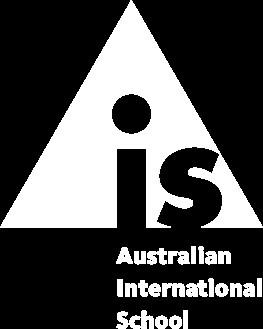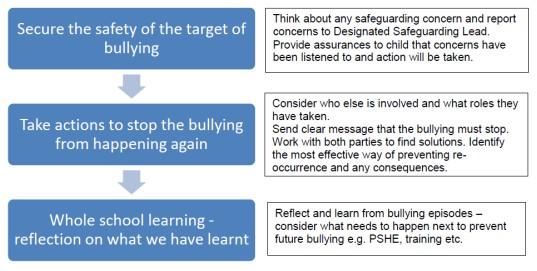

Document Title: Anti-Bullying Policy
- The policy defines bullying and sets out our schools anti-bullying procedures.
- We take all concerns regarding bullying seriously.
- We listen to students and take positive action to prevent bullying.
- We have measures in place to prevent all forms of bullying.
- Bullying and Discriminatory behaviour will be covered in our PSHE curriculum.
- Our focus is preventive in providing a positive, safe environment where behaviour is good, and students feel safe.
- We are aware that bullying can occur online and in the wider community, as well as at school.
- A bullying incident will be addressed as a child protection concern when there is risk of significant harm to the victim/s and the perpetrator/s.
1. Introduction
1.1. We aim to establish a whole school positive culture in which all members of the community feel safe and confident, and treat each other with respect and courtesy, particularly with regard to individual differences. To this end, bullying will not be tolerated in our school.
1.2. This policy should be read and understood in the context of our behaviour policy, our Equalities and Diversity policy, our Safeguarding Policy, our Digital Safety Policy and our approach to Personal, Social, Health and Economic education.
1.3. We respect differences and welcome diversity in our children, staff and school community and believe our school should be inclusive.
1.4. We believe that students have the right to feel safe, and secure and that creating a safe environment and dealing with bullying is everyone’s responsibility.
1.5. We support a range of positive strategies to deal with bullying and will adopt intervention strategies to tackle bullying behaviour.
1.6. Bullying can result in long-term physical and psychological damage and in extreme cases suicide.
1.7. Bullying incidents that occur off of the school premises such as online or in the local community will fall under this policy.
1.8. Bullying is considered as Child-on-Child Abuse, if the behaviour involves criminal activity and/or if the bullying behaviour is so serious, the police may be informed. Where possible we will aim to support both the victim/s and the perpetrator/s.
1.9. Parents will be informed of all bullying incidents, they will be expected to work with the school to identify issues and address the behaviour to prevent further incidents.
1.10.
2. Objectives
2.1. Our objective is to provide all students with a positive, safe environment free from bullying and discrimination. We will achieve this by;
Enabling students to understand clearly what constitutes bullying and to understand that bullying, whatever its form, will not be tolerated by the school community;
Making it easy for students to report bullying so that they feel assured that they will be listened to and incidents will be acted upon;
Raising staff awareness of the presence of different types of bullying and consistently challenging all forms of bullying or discrimination;
Training staff to recognise and respond to bullying and discrimination, and to be aware of the needs of children who have a protected characteristic, including students with a Special Educational Need, Disability or are LGBTQ+;
Establishing clear guidelines for responding to incidents of bullying;
Ensuring that the physical layout of our buildings and our safety mechanisms such as CCTV all help to discourage and reduce the risk of bullying;
Developing a range of strategies for students to learn about cultural, moral and social issues;
Celebrating success as an important way of creating a positive school ethos around antibullying; and
Enabling parents to feel confident that bullying incidents will be firmly dealt with by the school.
3. What is Bullying
3.1. Bullying is the repetitive, intentional hurting of one person or group by another person or group, where the relationship involves an imbalance of power. Bullying can be physical, verbal or psychological. It can happen face-toface or online.
3.2. Bullying behaviour can be;
Physical – pushing, poking, kicking, hitting, biting, pinching etc.
Verbal – name-calling, sarcasm, spreading rumours, threats, teasing, belittling.
Emotional – isolating others, tormenting, hiding belongings, threatening gestures, ridicule, humiliation, intimidation, manipulation and coercion.
Sexual – unwanted comments, taunts and gestures.
Prejudice-based and discriminatory, which may include but not be limited to: Racial, faithbased, gendered, homophobic/biphobic, transphobic, and disability-based. Examples include gestures, racial slurs or taunts, special education needs, name-calling, and making fun of customs/accents/choice
Extortion – demanding money/goods with threats.
3.3. Bullying can occur;
Face-to-face – At school, travelling to and from school (school bus) or in the community.
Online – Using mobile phones, social networks, email etc.
3.4. In the Early Years, what may appear as bullying is often not intentional or malicious, as young children are still developing essential social and emotional skills. At this stage, behaviours like grabbing toys, hitting, or excluding peers are often a result of limited language skills, impulse control, and understanding of others' feelings, rather than deliberate attempts to harm. It is crucial to take into consideration a child’s developmental stage, communication abilities, emotional regulation, and social awareness when addressing conflicts. In collaboration with caregivers, Early Years educators will focus on guiding children through positive interactions, teaching empathy, and helping them understand the impact of their actions. More severe instances of behaviour that could cause harm will be addressed through the Unsafe Behaviours policy.
4. Procedures
4.1. Any incidents of bullying or suspected bullying, should in the first instance be investigated. Those involved should be offered the appropriate pastoral support and a senior member of staff and the DSL should be informed.
4.2. It is important for the school to understand the motivation behind any bullying and whether it reveals any cause for concern about the safety of the perpetrator as well as the victim. This is because the perpetrator may also need support themselves.
4.3. Parents or guardians of both the victim and the perpetrator should be informed of all
incidents of bullying unless doing so puts them at additional risk of hurt or harm.
4.4. In rare circumstances where the bullying behaviour reaches the harm threshold (see International Safeguarding Policy) Child Protective Services (CPS) or the police should be contacted.
4.5. All incidents of bullying will be recorded in the first instance on CPOMS, as bullying is a known form of Child-on-Child abuse. This will also enable patterns to be identified and adequate support is given to the victim/s and perpetrator. Keeping records of bullying will enable the school to;
Manage individual cases effectively
Monitor and evaluate the effectiveness of strategies and interventions
Celebrate the anti-bullying work of the school
Respond effectively and swiftly to concerns from parents.
4.6. Following all incidents of bullying, it is advised that statements are gathered from the victim/s to establish the seriousness of the bullying, the duration of the bullying and the impact it has caused the victim/s.
4.7. Depending on the impact to the victim/s, counselling support will be offered, and if appropriate a safety plan and risk assessment created.
4.8. A meeting with the perpetrator will then be held to discuss the bullying behaviour, ascertain the reasons behind the bullying behaviour and share the impact their actions have had on the victim/s. If appropriate, a safety plan and risk assessment will be created.
4.9. Depending on the seriousness of the bullying behaviour, the school may want to refer to the behaviour policy and/or expulsion policy whilst deciding any consequences for the perpetrator.
4.10. Restorative practice should always be explored as a result of any bullying incidents. Restorative practice can only be successful if it is of the wishes of the victim/s, if those involved have the emotional maturity to take part, and if conducting a restorative meeting is likely to resolve the matter.
4.11. Regular welfare checks on both the victim/s and the perpetrator should be conducted for a period following any incident of bullying. The School will report back to all families. However, to ensure the confidentiality of all parties involved, specific details related to any actions taken will not be disclosed.
4.12. The school must review all patterns of bullying to see how these can be handled and reduced. This may include how bullying is addressed in the PSHE curriculum.
4.13. Where a serious incident occurs, the school will complete a Serious Incident Report Form (SIRF) and escalate to the Regional Safeguarding Lead (RSL).
4.14. If required, refer to the Safe Handling & Search Policy and Procedures.
5. Preventative Strategies
5.1. By knowing our students well, we will be in a positive position to identify bullying behaviours before they escalate into a serious incident. This includes being aware of situations in a child’s personal life that could impact the way they behave.
5.2. As a school we will actively and openly promote differences and act as role models to our students.
5.3. We will talk with students through the curriculum about issues of difference and use dedicated project time and events such as special assemblies. Our Digital Safety Curriculum will address cyberbullying and how to report incidents of cyberbullying when it occurs.
5.4. All incidents of bullying, discriminatory behaviour, and derogatory language will be challenged immediately and, where appropriate, consequences implemented.
5.5. We will talk with our students about appropriate physical boundaries and consensual touch, with all incidents challenged immediately and, where appropriate, consequences implemented. It is vital that following any such incidents, a report is made to the DSL to ascertain if the harm threshold has been met.
5.6. Our students will be made aware of who they can talk to if they don’t feel safe and what systems are in place to report bullying.
5.7. We will encourage our parents and the wider school community to report any concerns that could amount to bullying.
5.8. We will learn from previous incidents of bullying, to ensure measures are put into place that reduce incidents of similar nature.
5.9. We will have effective IT systems in place that include monitoring and filtering and preventing incidents of cyberbullying on school premises.
5.10. Our behaviour consequences for bullying are fair and consistent and our students will be made aware of the consequences regularly.
5.11. We will utilise external support in our community as a measure to prevent bullying.
5.12. Staff will be well-trained in identifying and responding to all forms of bullying and Child-On-Child Abuse.
6. Responding to Bullying

6.1. We will monitor and review all bullying incidents to determine patterns or trends that may require further action.
6.2. Students will regularly be given the opportunity to feedback on how safe and happy they feel at school, through the Voice of the Students, questionnaires, dedicated class time and student council meetings.
7. Reporting Bullying
7.1. If a student reports to an adult a bullying incident, they have the opportunity to discuss and record the incident.
7.2. Once a staff member becomes aware of a bullying incident, depending upon the nature of the bullying incident or allegation, it should be reported to one of the following: Head of Year, Wellbeing Coordinator, or AHOSS Wellbeing as identified in sub-school guidelines.
7.3. If there is a potential threat of harm, it is reported in CPOMS and the DSL is made aware.
8. Monitoring and Evaluation
8.1. This policy will be monitored by the Head of School.
8.2. This policy will be reviewed and evaluated by the Director of Education and the Regional Safeguarding Lead.


